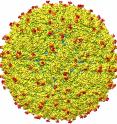Structure of Zika virus determined
A near-atomic level map of Zika virus shows its structure to be largely similar to that of dengue virus and other flaviviruses, but with a notable difference in one key surface protein, report scientists funded by the National Institute of Allergy and Infectious Diseases (NIAID), part of the National Institutes of Health. The variation in the Zika envelope (E) glycoproteins-- 180 of which are packed on the virus's outer shell-- may provide clues to better understand how Zika virus enters human cells and suggests ways to combat the virus with drugs or vaccines aimed at the newly detailed region. NIAID grantees Richard Kuhn, Ph.D., Michael Rossmann, Ph.D., and their colleagues at Purdue University created the picture of a mature Zika virus particle with a technique called cryo-electron microscropy. The process involves freezing virus particles and firing a stream of high-energy electrons through the sample to create tens of thousands of two-dimensional electron micrograph images that are then combined to yield a composite high-resolution, three-dimensional view of the virus. The team included NIAID investigator Theodore Pierson, Ph.D.
The difference visualized by the researchers is in a region of the E glycoprotein that flaviviruses may use to attach to some human cells. The variation in the E glycoprotein of Zika virus could explain the ability of the virus to attack nerve cells, as well as the associations of Zika virus infection with birth defects and the autoimmune-neurological Guillian-Barré syndrome. The structure could inform vaccine development, as the Zika E glycoprotein is a key target of immune responses against the virus. The information may also be useful for designing treatments such as antiviral drugs or antibodies that interfere with E glycoprotein function. Further, details on the structural differences between E glycoprotein of Zika virus and the same protein in dengue virus may make it possible to create diagnostic tests that can distinguish Zika virus infection from dengue infection, a critical need in countries where both Zika and dengue viruses are circulating.
Source: NIH/National Institute of Allergy and Infectious Diseases
Articles on the same topic
- Zika virus structure revealed, a critical advance in the development of treatmentsThu, 31 Mar 2016, 18:37:05 UTC
- Many in families with pregnant women don't know key facts about ZikaThu, 31 Mar 2016, 18:36:37 UTC
- Finnish study confirms link between Zika virus and fetal brain damageWed, 30 Mar 2016, 23:52:36 UTC
Other sources
- Protecting Pregnant Women in the US from Zika Is a Top Priority, Officials Sayfrom Live ScienceFri, 1 Apr 2016, 21:30:33 UTC
- State health officials urged to get ready now for Zika in USfrom AP HealthFri, 1 Apr 2016, 20:10:44 UTC
- Scientists solve Zika structure, identify possible fetal receptorfrom C&ENThu, 31 Mar 2016, 23:30:41 UTC
- Zika virus structure revealed, a critical advance in the development of treatmentsfrom Science DailyThu, 31 Mar 2016, 20:20:37 UTC
- Zika Revealed: Here's What a Brain-Cell-Killing Virus Looks Likefrom Live ScienceThu, 31 Mar 2016, 19:30:50 UTC
- See the Zika virus as you've never seen it beforefrom LA Times - ScienceThu, 31 Mar 2016, 18:42:17 UTC
- This Is What The Zika Virus Looks Like In Near-Atomic Detailfrom PopSciThu, 31 Mar 2016, 18:30:34 UTC
- Link between Zika virus and fetal brain damage confirmedfrom Science DailyWed, 30 Mar 2016, 23:50:41 UTC
- Zika virus: early fetal ultrasounds may not detect brain damagefrom CBC: HealthWed, 30 Mar 2016, 23:20:38 UTC
- CDC expands range of Zika mosquitoes into parts of Northeastfrom AP HealthWed, 30 Mar 2016, 22:20:38 UTC
- Zika highlights role of controversial fetal-tissue researchfrom News @ NatureWed, 30 Mar 2016, 21:20:41 UTC
- Many in families with pregnant women don't know key facts about Zikafrom Science DailyWed, 30 Mar 2016, 19:20:50 UTC
- Study explores mechanism linking Zika virus, birth defectsfrom UPIWed, 30 Mar 2016, 16:20:39 UTC
- Zika Misperceptions: Many in US Unaware of Key Factsfrom Live ScienceTue, 29 Mar 2016, 21:31:07 UTC
- Many Americans misinformed about Zika virusfrom UPITue, 29 Mar 2016, 21:30:36 UTC
- UF/IFAS Researchers Head to Brazil Seeking Zika Answersfrom Newswise - ScinewsMon, 28 Mar 2016, 14:00:43 UTC
